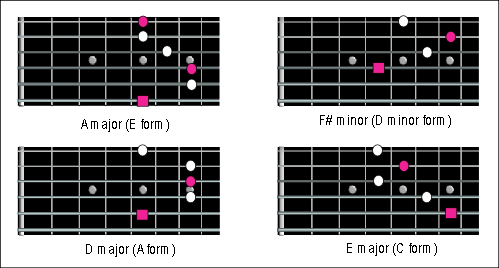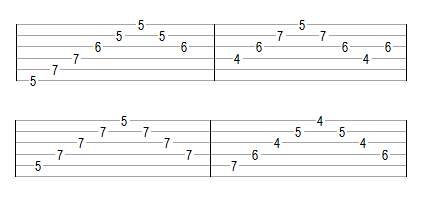Playing chords in one position
Two of the biggest differences between pro and amateur guitar solos are knowing when to play the right notes at the right time and making those note transitions work smoothly. This is something that you might think would take years to accomplish but it’s not really that hard. Sure it takes some time but the biggest hurdle the beginner guitarist has overcoming this problem is most beginner and amateur guitarists just don’t know how to go about practicing this kind of stuff. Where do you start?
Learning the notes on the fretboard is definitely a big deal and helps your guitar solos massively but a lot of rock and blues use a lot of very common chord progressions. This is the best place to get started on putting the CAGED system to good use and see some real benefits in a short amount of time from the CAGED method.
Knowing the CAGED chords and being able to find them quickly is the easiest way to make use of chord tones in your guitar solos. Once you know these very well then you can use the system to make sure you land on the good sounding notes whenever the chords change in a chord progression. You know those guitar solos you hear that always sound so natural and flowing with the music, those are the ones that make sure the chord changes are reflected within the solo itself as well as the other instruments playing the backing. If a solo is self supporting then it’s always going to fit well within the rest of the band.
Once you have this kind of stuff down then you are on your way. Don’t get too excited though, there is a lot to learn yet, this is just the basics of putting the CAGED guitar system to good use. The toughest part is getting so used to it that you can move to any chord while moving your fretting hand as little as possible away from it’s current position. Why? Because this is how you get your guitar solo to sound so smooth and fit perfectly with the music. If you can manage to choose notes within your guitar solo that change between the chords with the least amount of distance, this is when you start to sound like a real pro. We can’t rush ahead this fast so for now lets just take an example chord progression and look for the CAGED chords that are closest to the position we are playing. For this example lets say we are around the fifth fret and using the following chord sequence.
Chords: A / F# minor / D / E
Here are the CAGED chords around the fifth fret.

Being able to find those patterns quickly takes some practice and the more you know the notes on the fretboard the better. It really doesn’t take very long to do learn any of these things, here’s a fact, most beginners spend more time looking for answers and tricks on how to learn the fretboard than it actually takes to learn them with the correct practice!
Just do a few exercises everyday, it doesn’t need to be anything in particular.. Just pay attention to what you are playing and practice the above idea in all twelve keys regularly, within a month you’ll be well on your way. Within a few months you could know the entire fretboard with ease as long as you stay focused and make sure you are learning and not just going through the motions. I’ll do an in depth lesson on that another time but right now lets stick with the CAGED system!
For now, all you need to do is practice the above chords in those positions. Don’t worry if you find them difficult to finger, the point is to get to know the note positions and chord patterns. When it comes to creating our guitar solos, we want all of those notes firmly fixed in our minds without any thought required. It’s good if you can play them as full chords but for the sake of what we are learning here, you only need to play the notes. The TAB below will give you the idea. Practice regular for a few days and then you will be ready to move on to the next lesson.

This system is great and I get how to use it all, but I don’t know the notes on the first 4 strings very good. Should I remember CAGED by the notes in the chords, or should I mainly use the chord forms as a guide? Thanks
Hi ben
You should absolutely learn the notes. The chord forms are just as important but ideally you should know where the root notes are in every chord form and use them as your guide to finding your way around the fretboard. Once you can do this you will see the power of the CAGED system and your guitar playing will improve dramatically.
So what’s the best way to start practicing? Should I start with the TABs above and figure out what each note is as I play? Should I start with those forms above and figure out where those chords are?
Also, what’s the significance of the squares and pink circles? Is the square the root note?
thanks,
Mike
@Mike
The idea is to learn all the notes in each chord everywhere on the fretboard. That’s the ultimate goal but it takes time. It’s good to learn the note names as well as the intervals. Start small and learn them one step at a time, preferrably over a backing track otherwise it gets boring and pointless if you can’t hear how it sounds.
Once you get well aquainted with those notes, start incorporating them into your normal scale playing. Try landing on any of the chord tones each time the chord changes. Over time, your soloing will start sounding better and work well with the underlying chord changes.
The pink notes are all root notes, the square one is just the starting root, it’s just how I made the diagrams, they could have all been just pink or all square.
What are the white dots for?
Do I put my fingers down for the square dots?
this is more confusing than ever.
Where is the G form?
The white notes represent where you position your fingers. The pink notes are the root notes, for example if you look at chord a; check out the 5th fret of the 6th string(the low e) then notice the 7th fret of the 4th string(the a) and then check out the 5th fret of the 1st string(the high e) each note is highlighted in pink because they are each the “a” note, hence the root# of the Achord position.
The pink square represents the starting root note of the chord.
sorry, not to confuse, haha. you place your finger on each dot, the pink dots also represent that you are on a root note*** 🙂
What pink notes?
I’m a bit confused about the f# minor chord in the d minor position. If A major is in the E major position then it seems that by the caged method, the d minor position should be higher on the fretboard, and it seems as if it should start on the seventh fret of the D string if we use consistency from the previous lessons. Now, I can see that that the f# chord you provided is in fact an f# and it is using the d minor pattern, but it doesn’t seem to be in the d minor position in relation to the E major position for the A major chord. It’s a bit confusing because if we follow the pattern, A minor should be in the D minor position, so where am I going wrong?
Andrew … be careful not to confuse position with form. Think of “form” as the pattern and “position” is where you play that form (pattern). The point here is to be able to visualise chord forms so that you can find the chord tones of a chord sequence with minimal movement across the fretboard.
There is no A minor in this example, the chords are A major, F# minor, D major and E major (a common chord progression) using the various caged forms to keep them grouped in close proximity to each other. Does that make sense?
I’m taking inter/advanced guitar at the local JC and also a theory class. This theory class has opened up everything for me. It takes a while to wrap yer melon around some of the basics, but it sure helps.
hi thanx for helping us! so again really before any REAL progress can happen one needs to know all the notes on the fret board thats STEP 1 right?
I’m 46 and have been playing the guitar since 1980. Only in the last few months have I learned the notes on the neck, and it’s opened up the concepts miraculously.
I can play the Major CAGED chords (no one ever suggested the minor forms or the 7th or the diminished for that matter, and it never occurred to me) and the minor pentatonic shapes and they make sense theoretically now. They used to just be shapes.
For those learning the notes on the neck, I suggest learning the ABCDEFG and don’t worry about the sharps and flats for now. When you know the ‘normal’ notes, the sharps and flats are pretty easy.
Knowing the notes makes all the theory MUCH easier to understand.